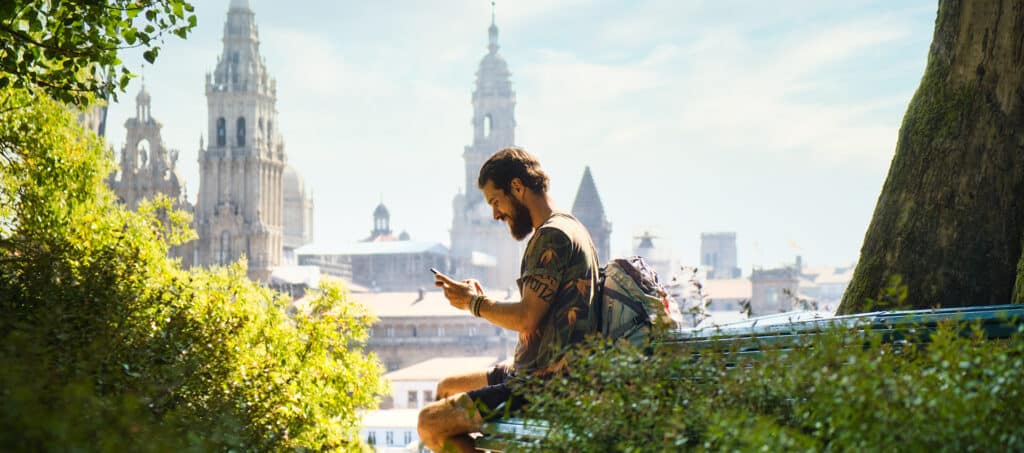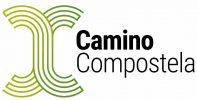
The Camino de Santiago is more than a hiking trail. If it weren’t, hundreds of thousands of pilgrims wouldn’t arrive in the capital of Galicia every year from all parts of the world. For many people, it is a transformative journey in which they seek more than just a vacation, a life experience.
Throughout this article, from Camino Compostela, we will review the top five symbols of the Camino, where each one has its own story. The first on this list is the scallop shell, the most emblematic symbol of the Camino de Santiago.
1. The Scallop Shell and the Camino
When we talk about the Camino de Santiago, the first thing that comes to mind is the symbol of the scallop shell. This connection dates back over a thousand years when pilgrims who reached Santiago were awarded a scallop shell as proof of their journey. That’s why we include it as one of the main symbols of the Camino de Santiago.
Over time, the scallop shell became an icon of the pilgrimage to Compostela, loaded with religious and symbolic meanings. In fact, any pilgrim can observe its representation in many scenarios.
In addition to the symbolism that links it to the Camino de Santiago, this mollusk is one of the icons of Galician cuisine (in its various forms of preparation), experiencing a surge in demand during Christmas dinners for many families. We leave you a link so you can see how to make traditional Galician recipes at home
2. Milestones and the yellow arrow: the ‘lighthouses’ for pilgrims
While the scallop shell is the quintessential symbol of the Camino de Santiago, and everyone, whether they have completed it or not, establishes the connection between the shell and the Jacobean route, another of the most famous icons is milestones or markers. They are the ‘lighthouses’ that indicate the way to any pilgrim.
Many people are surprised when they hear the term for the first time because, in other circumstances, the word carries negative connotations. However, it is something that helps not to forget the name.
They are easily recognizable. Basically, the milestones are structures made of granite, stone, or concrete with an arrow painted on them that indicates the correct direction of the route. The idea of the arrow came from the parish priest and one of the greatest scholars of the Camino, Elías Valiña.
They measure about one meter in height and are made of granite or stone, and they are found every few hundred meters on any route of the Camino de Santiago. Depending on the autonomous community, you can see different shapes and designs, as well as finding them in a wide variety of locations.
On the other hand, sometimes stones are seen on top of the milestones. It dates back to the Middle Ages when pilgrims, not having technology, marked the safe route by placing a stone in their path. This tradition has been maintained to the present day, although for various reasons, such as gradually leaving behind some of the weight along the Camino.
In 1993, the Xunta promoted the Camino through the Plan Xacobeo and decided to standardize the milestones. This achieved uniformity in terms of signage (including detours to historical and religious sites of importance). They added the arrow to indicate the correct direction, the kilometer indication, and a space indicating the autonomous community, in addition to modernizing the constructions that can be seen today.
3. The Cross of Santiago
The origin lies with medieval knights, while currently it represents an inner journey. The constant presence of this symbol along the Camino reminds pilgrims of the historical and spiritual legacy they are following, as well as a reminder of the protection that has characterized the route throughout the centuries. It is the symbol that represents the ‘magic’ that surrounds the Camino, with a selfless and altruistic aura.
With a sword shape and red color, the Cross of Santiago is the emblem of the Santiago´s Order of Knights, founded in 1170. This religious and military order had, among other duties, the mission of protecting pilgrims at a time when Christians were reclaiming territories in Spain from the Muslims during the Reconquista.
Today, these religious connotations have disappeared, but not the values they represented, such as the protective and altruistic mission along the route. The Cross of Santiago has been integrated into popular culture and art beyond the Camino. It can be seen on the coat of arms of the Santiago City Council, in Galician pastries (like the Tarta de Santiago), or in football teams, such as the Real Club Celta de Vigo.
4. From the pilgrim’s staff to the walking stick
The pilgrim’s staff is one of the most commonly used tools by pilgrims on the Camino de Santiago since its inception. In addition to being a physical support on challenging terrain, the staff is a symbol of strength and resilience. It is the witness of the pilgrim’s journey, mentioned in numerous texts of the Codex Calixtinus and depicted in various works of art, almost always linked to the pilgrim.
In the early days of the Camino de Santiago, in addition to serving as a support point for overcoming obstacles, it was used as a tool to protect oneself from wild animals or bandits. With the passage of time, these functions became obsolete, as did the type of original pilgrim’s staff (although it can still be found for sale in almost all pilgrim souvenir shops), in favor of more modern hiking poles.
The original pilgrims of the Middle Ages were accompanied, in addition to a staff, by a gourd (similarly, they can be found together in many shops). This ancient flask was not only a tool for carrying water or wine but also a symbol of solidarity and brotherhood among the walkers as it was shared among them. In the same way as the staffs, it is rare to see pilgrims using gourds as water bottles, as they have been replaced by more modern containers, such as aluminum bottles
5. The Pilgrim’s Credential and the Compostela:
This Camino passport is a ‘living’ diary of each walker’s journey. With each stamp, not only is the physical progress documented, but also indelible memories are gathered with each step and testimonies of the friendship and hospitality found along the way.
This passport certifies having walked at least 100 km on a Camino route, and at the end of the journey, at the Office of the Pilgrim’s Reception, on rúa das Carretas number 33, about 200 meters from the Cathedral, one receives the Compostela (erroneously called ‘Compostelana’). To do this, in addition to covering the minimum required distance, it is necessary to have filled in at least two stamps on each stage. It is the diploma that records the experience of each pilgrim in writing.
From ‘Ultreia et Suseia’ to ‘Buen Camino’
While the pilgrim greeting is not a symbol that can be seen with the eyes like the ones detailed earlier in this article, it holds a special meaning on the Camino de Santiago. The pilgrim greeting is so characteristic of the route that we have to include it as one of the symbols of the Camino de Santiago.
People who decide to do the Camino de Santiago in 5 or 6 stages have to get used to it. Adapting to the circumstances of the Camino on the first day and evolving as the days go by is a very typical image. As the days go by, you will get used to the characteristic greeting of “¡buen camino!” and respond in kind. It’s a great way to encourage each other along the journey.
In the past, this expression came from the Latin ‘Ultreia,’ which translates to ‘let’s go’ or ‘forward’ in Spanish. The response was ‘Et Suseia,’ much like Buzz Lightyear in the movie Toy Story, ‘and beyond.’ The complete expression ‘Ultreia et Suseia’ is already mentioned in the 12th century in the Codex Calixtinus.
The true symbol of the Camino is the ‘magic’ that permeates it.
However, the symbols of the Camino de Santiago are still a reflection of centuries of pilgrimage to Compostela. The true symbol is the ‘magic’ that can be felt along the way. This adventure is an opportunity to rediscover yourself, surrounded by the majesty of nature and the richness of history. If you already have in mind to undertake the Camino but have doubts about which one to choose, we can help you.
